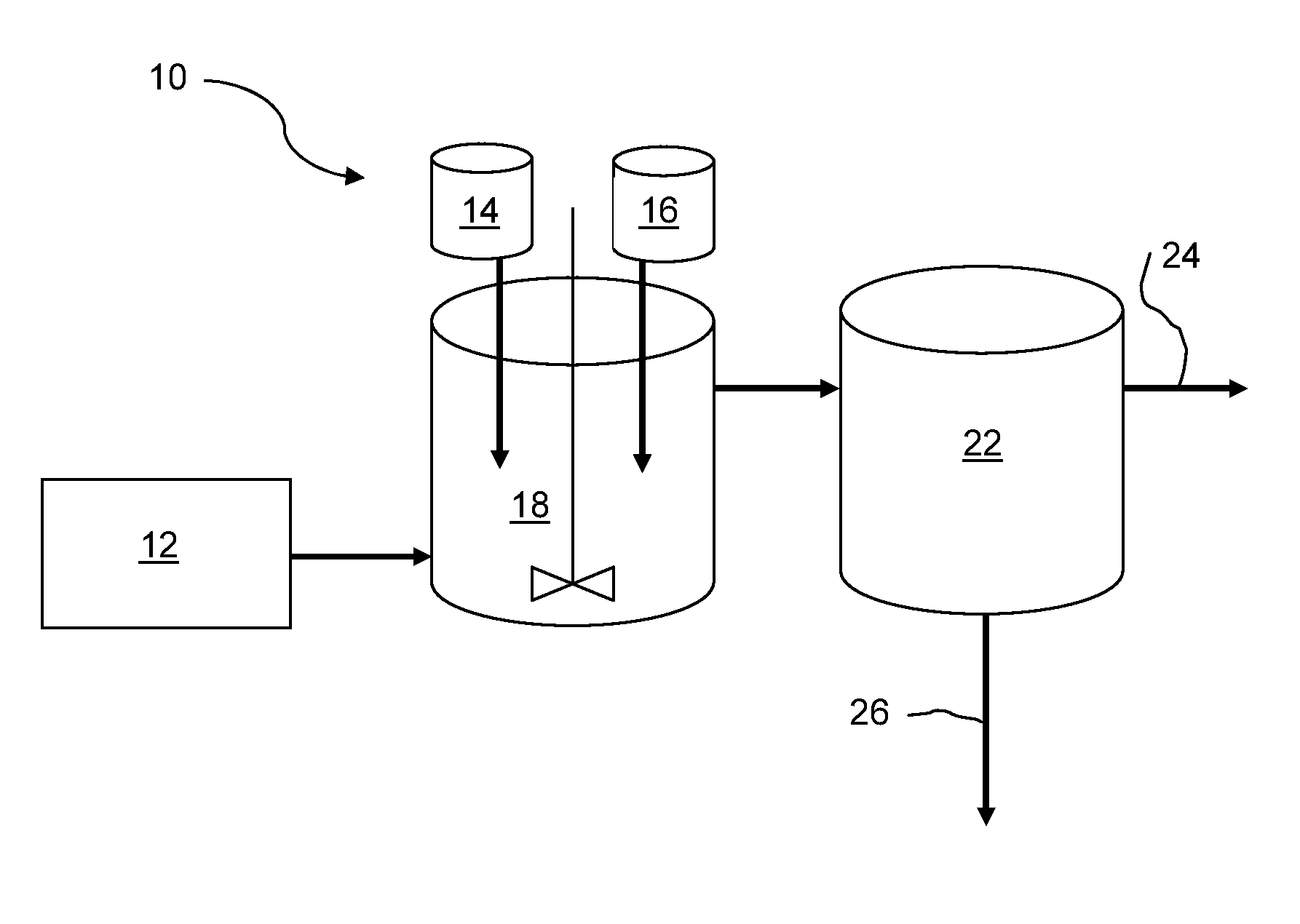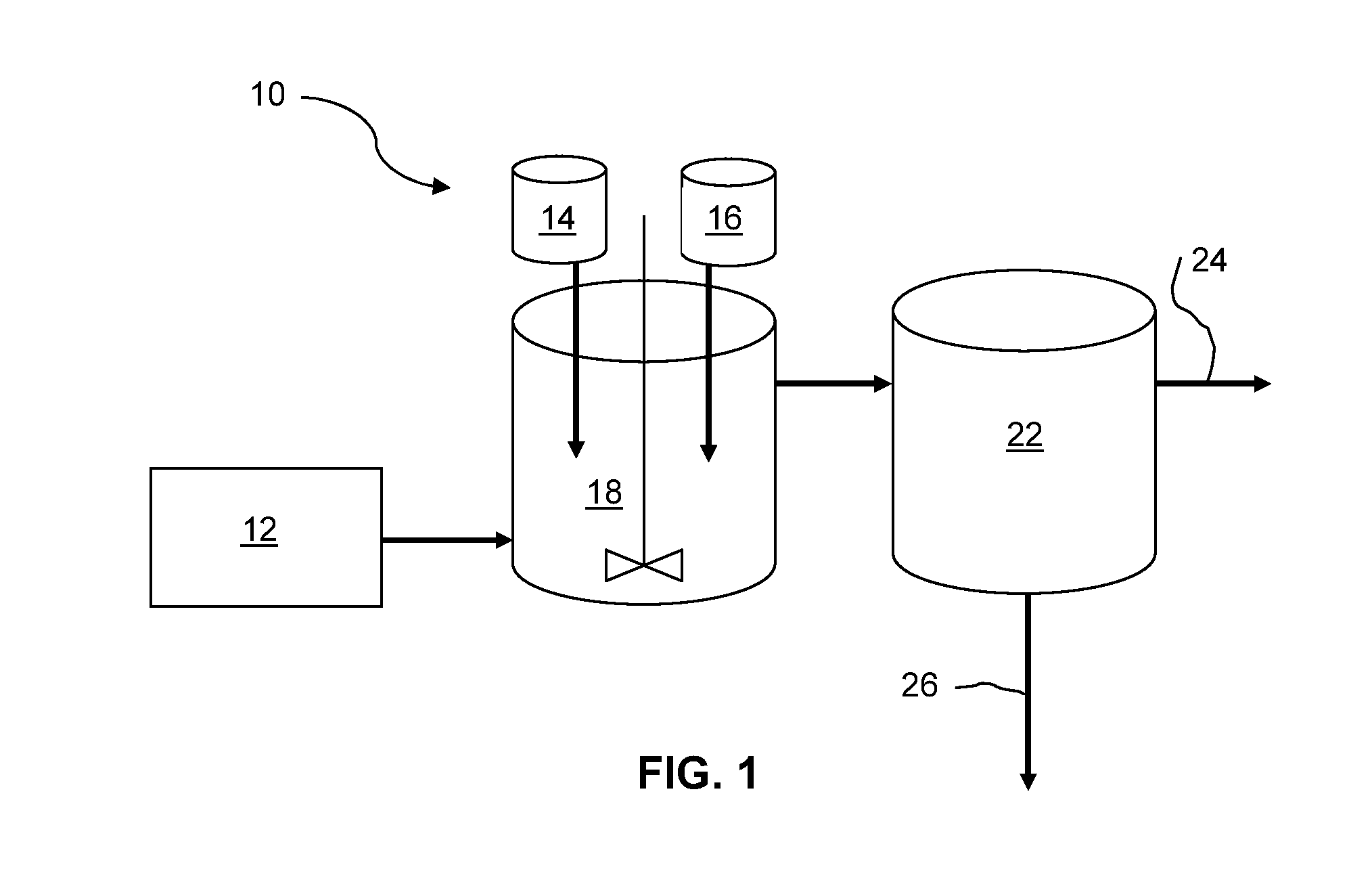Process for Hardness and Boron Removal
a technology of boron removal and hardness, applied in the direction of separation process, multi-stage water/sewage treatment, nature of treatment water, etc., can solve the problems of raising ph, affecting the quality of produced water, and not being able to remove methanol very effectively, so as to reduce hardness and reduce hardness
- Summary
- Abstract
- Description
- Claims
- Application Information
AI Technical Summary
Benefits of technology
Problems solved by technology
Method used
Image
Examples
examples 1-3
Boron Removal and Hardness Reduction Using LSS and Al(3+)
[0050]Al(3+) containing compounds (such as AlCl3) and liquid sodium silicate (LSS, 38.2% of Na2SiO3) were added into wastewater samples in varied amounts and mixed. The samples were settled and then filtered through 25 μm filter paper, which served as the filtration / separate stage 22 as in FIG. 1. Raw water and treated water were analyzed with Inductive Coupling Plasma (ICP). The waste water contains calcium (Ca), magnesium (Mg), strontium (Sr), boron (B), silicon (Si) and other contaminants. Adding silicate into water increases solution pH and forms magnesium hydroxide (Mg(OH)2), calcium hydroxide (Ca(OH)2) and strontium hydroxide (Sr(OH)2), and alumina hydroxide (Al(OH)3) precipitates. Silicate reacts with metal ions (such as Ca2+, Mg2+, Sr2+) and forms precipitates of CaSiO3, MgSiO3. Alumina (Al3+), silicate and other metal ions (such as Ca2+, Mg2+, Sr2+) could form alumina silicate precipitates. Boron removal was achieved ...
example 1
[0052]Water sample 1 was synthetic water with Ca, Mg, Sr and B as further specified in Table II. The adding of 660 mg / L of SiO32− and 288 mg / L of Al3+ reduced 80.1% of total hardness and 60.7% of boron. Solution pH increased from 7.9 to 9.48. Adding more Al3+ lowered pH due of forming of Al(OH)3 precipitate, did not increase total hardness removal, but increased boron removal.
TABLE IIChemistry of Water Sample 1 Before and After TreatmentTreatment (Chemical Total Amount)SiO32− (600SiO32− (600SiO32− (600Ionmg / L) + Al3+mg / L) + Al3+mg / L) + Al3+(mg / L)Raw(240 mg / L)(568 mg / L)(1280 mg / L)Al0.230.0310.3290.012B93.036.531.522.05Ca515155165145Mg37318.334.839.98Sr207.5126137.28101.75Total3087.2612.8694.7650hardness (asCaCO3)Hardness—80.1%77.5%78.94%removalSi10.658055.736.47pH7.99.489.068.51
example 2
[0053]Water sample 2 was synthetic water with Ca, Mg, Sr and B as further specified in Table III.
TABLE IIIChemistry of Water Sample 2 Before and After TreatmentTreatment (chemical total amount)SiO32− (450SiO32− (450SiO32− (450Ionmg / L) + Al3+mg / L) + Al3+mg / L) + Al3+(mg / L)Raw(230 mg / L)(460 mg / L)(1280 mg / L)Al0.2650.2530.2260.04B1496760.637.85Ca546179188188Mg20411.418.229.8Sr216135129115Total2470.62654.76698.49730.26hardnessHardness—73.49%71.73%70.44%removalSi11.988.16122.45pH7.649.519.218.1
PUM
 Login to View More
Login to View More Abstract
Description
Claims
Application Information
 Login to View More
Login to View More - R&D
- Intellectual Property
- Life Sciences
- Materials
- Tech Scout
- Unparalleled Data Quality
- Higher Quality Content
- 60% Fewer Hallucinations
Browse by: Latest US Patents, China's latest patents, Technical Efficacy Thesaurus, Application Domain, Technology Topic, Popular Technical Reports.
© 2025 PatSnap. All rights reserved.Legal|Privacy policy|Modern Slavery Act Transparency Statement|Sitemap|About US| Contact US: help@patsnap.com



